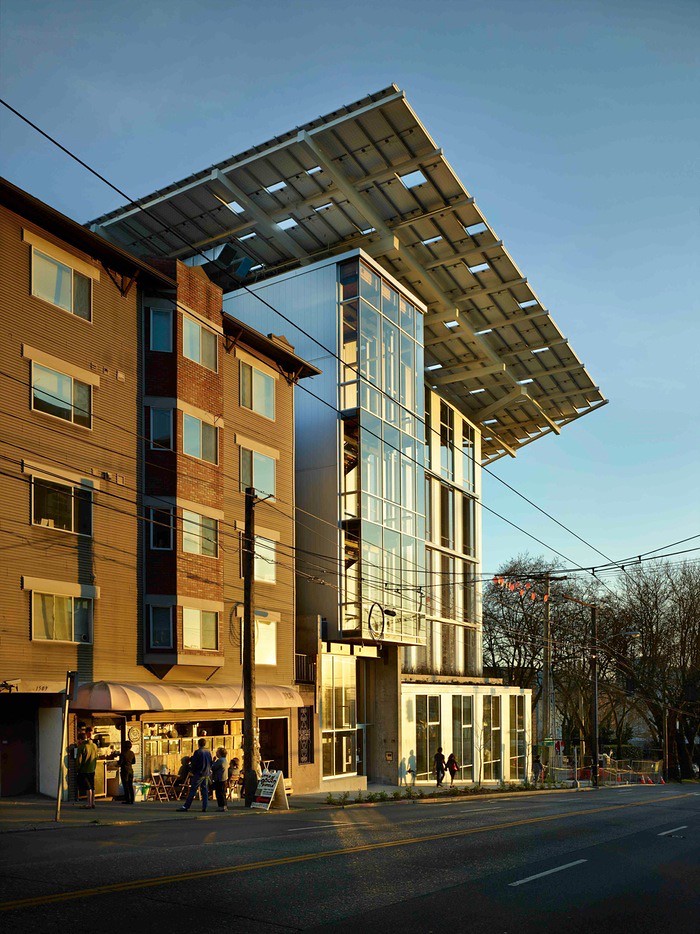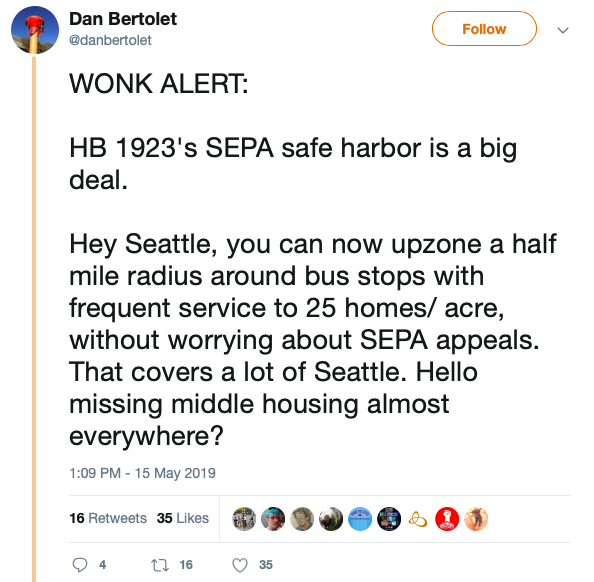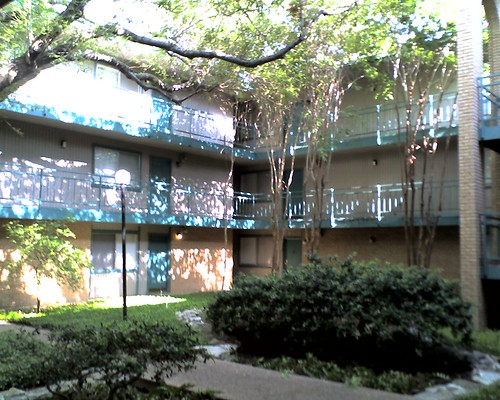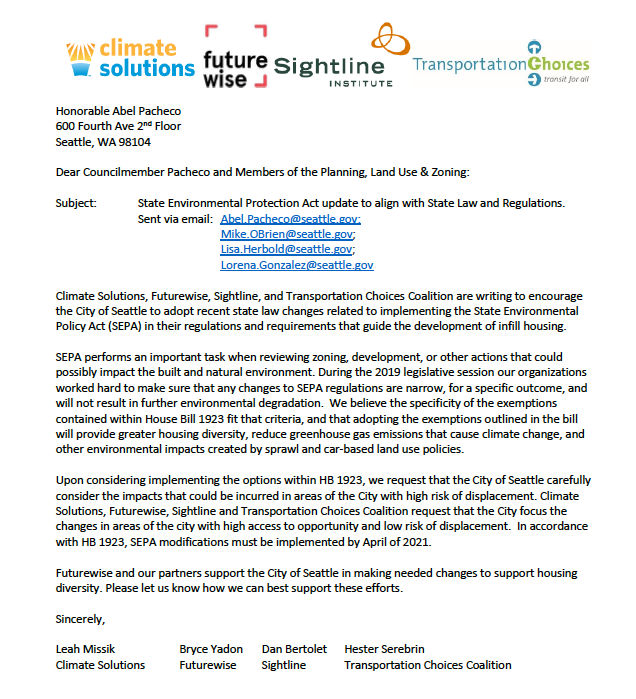Since its passage in 1971, the State Environmental Policy Act (SEPA) has been a cornerstone of environmental protection in Washington State. However, in recent years SEPA has become more readily identified with obstruction than protection. SEPA appeals have been used to create decades long delays for projects such as completion of the “Missing Link” of the Burke-Gilman Trail in Ballard and construction of affordable housing at Fort Lawton near Discovery Park in Magnolia. Implementation of backyard cottage reform and Mandatory Housing Affordability (MHA) in Seattle were also both impeded significantly by SEPA appeals.
It’s important to note that Seattle is not the only jurisdiction in Washington to be impacted by SEPA lawsuits. Across the state, many smaller cities have avoided updating their land use and zoning laws out of a fear that proposed developments could trigger costly legal battles they cannot afford to take on.
Thus fear of SEPA lawsuits has quietly suffocated development of new housing supply across the state, leading Dan Bertolet, Senior Researcher of Housing and Urbanism at Sightline, to call SEPA in its current form “a bane to sustainable urban development.”

That was certainly not what SEPA’s creators hoped its legacy would be almost fifty years on, and it is why some local environmental leaders, including Seattle Councilmember Mike O’Brien have expressed enthusiasm for state level legislation passed earlier this year in House Bill 1923, which provides cities with a menu of options for increasing their housing density and then provides “safe harbor,” or protections from SEPA lawsuits, for actions taken from that menu.
“I have not seen in my ten years here an environmental group challenge the SEPA analysis, and that is why I believe we have environmental organizations here today saying we are ready for this to be changed because this law which we have supported is being used to undermine the very policies we are trying to advance,” said Councilmember O’Brien in a recent Planning, Land Use, and Zoning Committee meeting in which he and Councilmember Abel Pacheco introduced Council Bill 119600, which would align Seattle’s environmental review process with recent changes state level changes made to SEPA.
“For too long, SEPA, a well-intended tool originally designed to protect our environment, has been used to delay policies and projects that are desperately needed to address our joint climate and housing crises,” Councilmember Pacheco said in a press release describing the proposed legislation and timeline for implementation.

What process does Seattle need to follow to gain SEPA safe harbor?
According to Bryce Yadon of Futurewise, passage of the legislation put forth by Councilmembers O’Brien and Pacheco would be the first step toward gaining SEPA safe harbor eligibility for certain projects in Seattle.
Under Council Bill 119600, the City would:
- Align City code with new state law House Bill 1923 that exempts some City Land Use Code changes from SEPA appeals;
- Limit Hearing Examiner SEPA appeal hearings to 120 days, with an option to extend to 150 days if all parties agree;
- Clarify that additional and voluntary subjects covered in an Environmental Impact Statement are not subject to appeal;
- Update SEPA thresholds for Urban Villages to exempt projects with less than 200 units and 12,000 square feet; and
- Allow the Seattle Department of Construction and Inspections to create a SEPA Handbook that provides guidelines for consistent analysis.
Underscoring the challenge at hand, even taking this first step toward SEPA reform will take a few months. Councilmember Pacheco has set out a preliminary schedule for consideration of the legislation by the Planning, Land Use, and Zoning Committee.
- August 7, 9:30am: Committee briefing and discussion of proposal
- September 4, 9:30am: Additional Committee briefing and discussion
- September 9, 5:30pm: Public Hearing on proposed changes
- September 11, 12:00pm: Committee vote on proposal
- October 7, 2:00pm: Full Council vote on proposal

SEPA reform has been a contentious topic in Seattle for a long time, and with both supporters and detractors already weighing in on the proposed legislation, it seems likely that September’s public hearing will bear many similarities to the public hearings that led up to both citywide MHA implementation and backyard cottage reform earlier this year.
Given the voting record of the City Council, the expectation is that Council Bill 119600 will pass in October. For housing affordability and density advocates, this is when things will become really interesting because it will be when the City will decide which options for adding density it opts into from the menu provided in House Bill 1923.
The options in House Bill 1923 include:
- Upzoning areas of at least 500 acres that include a commuter or light rail station;
- Upzoning areas of 250 acres or more that include bus rapid transit (only applied to cities with a population of forty thousand or more residents);
- Authorization of duplexes, triplexes, and courtyard apartments in single-family zoned areas;
- Authorization of accessory dwelling units (ADUs) in single-family zones areas on lots that meet size requirements;
- Adoption of a subarea plan or a detailed plan for a smaller geographic area within a city;
- Implementation of planned action, some examples include a comprehensive plan, master planned development, or phased project;
- Adoption of increases in categorical exemptions that encourage urban infill development;
- Adoption of a form-based code which includes zoning requirements based on physical form rather building use;
- Authorization of duplexes on each corner lot within all single-family zoned areas; and
- Allowances for subdividing lots into smaller parcels.

The City will have the right to opt into as many options as it chooses to, and how significant the impact of the legislation will be depends on what options are chosen. Because of how the calendar is unfolding, the current council should be able to make the calls on what actions will be implemented, although longer term stewardship will rest with the future council elected in November. Additionally, Mayor Jenny Durkan will be also weighing in on what options are selected to enact. Although the Mayor has been supportive of citywide MHA and backyard cottage reform, whether or not she will support actions such as authorizing triplexes, duplexes, and courtyard apartments in single-family zones is an open question. (These areas constitute her base of support.)
Important equity considerations hang in the balance as well
In a letter addressed to the council encouraging them to take advantage of the SEPA reform opportunities presented in House Bill 1923, advocates acknowledged the importance of equity considerations and urged the council to “focus the changes in areas of the city with high access to opportunity and low risk of displacement.”

This because so many zoning changes have historically occurred in the “areas of least resistance,” said Yadon of Futurewise. These areas are often home to residents who are lower income and have less resources and access to planning.
The City could be prescriptive about how it implements the actions in House Bill 1923, Yadon said, steering them away from areas acknowledged as already being at high risk of displacement.
This would present a major departure from the past when more affluent neighborhoods, such as Magnolia in the case of Fort Lawton, used costly SEPA lawsuits to prevent or delay new development in their neighborhoods.
The tension between who has been able to use SEPA as a recourse and who has not was a major topic of conversation at the committee meeting in which the legislation was presented. “It does seems like we’re doing a disservice to our community at-large when we do allow for those who have access to the ability to have deep funded pockets to fund attorneys,” said Councilmember Teresa Mosqueda, who has advocated for impacts to be analyzed through a race and social justice lens.
The importance of making the SEPA appeal process equally available to all the people of Seattle was also reiterated by Councilmember O’Brien, who called the current situation “very inequitable.”
Natalie Bicknell Argerious (she/her) is a reporter and podcast host at The Urbanist. She previously served as managing editor. A passionate urban explorer since childhood, she loves learning how to make cities more inclusive, vibrant, and environmentally resilient. You can often find her wandering around Seattle's Central District and Capitol Hill with her dogs and cat. Email her at natalie [at] theurbanist [dot] org.



